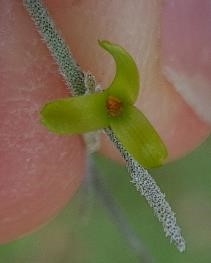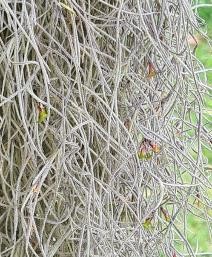Spanish moss
Description
Spanish moss, commonly known as Old Man’s Beard, is a perennial monocotyledon in the pineapple family that grows abundantly from the Southern United States to the cooler regions of Argentina and Chile. It tolerates a huge range of temperatures and annual rainfall.
Spanish moss is an epiphyte that forms hanging festoons up to 8 m long which loop over branches and catch in cracks and crevices in bark to start new festoons. The festoons are made up of numerous shorter plants twisting around and overlapping each other.
It grows slowly, is not allelopathic nor drought tolerant, has low fertility requirements, is a medium moisture user, requires a pH of 6 to 6.9, has no salinity tolerance and is shade tolerant.


The small green flower is present from spring to autumn. The fruit is a capsule up to 25 mm long but we failed to find any mature fruit from November 2023 to June 2024. The flower rarely successfully self-pollinates. The seed is uncommon and is produced in autumn and winter. Seeds have feathery parachutes that enables them to float like dandelion seed. Seeds have no seed dormancy and can spread up to approximately 250 m away from the nearest Spanish moss but spread is not rapid under normal conditions.
The surface of Spanish moss plants is covered with tiny, grey scales (trichomes) that trap water and nutrients which then move by capillary action on the outside of the plant. Vascular transport is unimportant. Rain, dew and fog are more important than relative humidity. Water loss is reduced by crassulacean acid metabolism photosynthesis that allows gas exchange at night. In the Southern United States, Spanish moss is often found by ponds as clearing, frequent fires and barriers of dense pines prevent growth elsewhere. It generally grows best in high light conditions.
